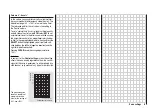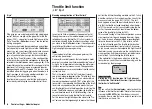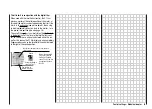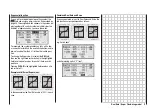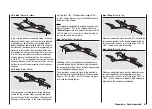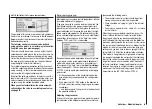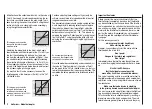
62
Mixer neutral point
(offset)
The neutral point of the mixers
Aileron
NN
Elevator
NN
Flap
NN
is by default the zero point of the transmitter control, i.e.
that is the point at which they have no effect. At the end-
point of the transmitter control the full mixer value is ap-
plied.
The default neutral point (“offset”) of the mixers
Airbrake
NN
is the front position of the C1 stick (throttle / airbrakes),
at which the airbrakes are
always retracted.
diff aile.
(differential aileron travel)
Aileron differential compensates for an unwanted side-
effect which occurs when ailerons are defl ected: the pro-
blem known as “adverse yaw”. When the ailerons are
defl ected, the drag generated by the down-going aileron
is greater than that produced by the up-going aileron.
The differential drag causes a yawing motion around the
vertical axis in the opposite direction to the desired turn.
This effect is much more pronounced in model gliders
with high aspect ratio wings than in power models with
their much shorter moment arms, and usually has to be
countered by giving a simultaneous rudder defl ection in
the opposite direction to the yaw. However, this in turns
causes additional drag and lowers the aircraft’s effi cien-
cy even further.
Electronic aileron differential is one answer, but it can
only be used if a separate servo is employed for each
aileron. Aileron differential reduces the angular travel
of the down-going aileron relative to the up-going ai-
leron, and this reduces the drag and therefore the ad-
verse yaw. However, this method can only be applied if
each aileron is actuated by its own servo, usually moun-
ted in the wings themselves. The shorter pushrods also
result in virtually slop-free aileron linkages with reliab-
le centring.
Mechanical solutions are also possible, but they usually
have to be “designed in” when the model is built, and the
degree of differential cannot be altered subsequently. In
any case signifi cant mechanical differential tends to cau-
se additional slop in the control system. Electronic diffe-
rential offers the following important advantages:
It is easily possible to vary the degree of differential wi-
thout affecting the travel of the up-going aileron. In one
extreme it is possible to suppress the down-aileron de-
fl ection completely, i.e. only the up-going aileron moves
at all, and this arrangement is sometimes called the
“split” setting. Split ailerons not only tend to suppress
adverse yaw, but can even generate positive yaw, which
means that the model yaws in the direction of the turn
when an aileron command is given. In the case of large
model gliders, smooth turns can then be fl own using ai-
lerons alone, which with most models of this type is usu-
ally by no means the case.
The adjustment range of -100% to +100% makes it pos-
sible to set the correct direction of differential regard-
less of the direction of rotation of the aileron servos.
Wing mixers – Fixed-wing model
“0%” corresponds to a normal linkage, i.e. no differential,
while “-100%” or “+100%” represents the “split” function.
For aerobatic fl ying it is necessary to set low absolute
differential values, to ensure that the model rotates ex-
actly along its longitudinal axis when an aileron com-
mand is given. Moderate values around -50% or +50%
are typical for making thermal turns easier to fl y. The
split setting (-100%, +100%) is popular with slope fl y-
ers, when ailerons alone are often used for turning the
model.
Note:
Although it is possible to enter negative values in order
to reverse the direction of servo rotation, this is not usu-
ally necessary if the correct channels are used.
diff. fl aps
(Camber-changing fl ap differential)
The aileron / fl ap mixer (see below) is designed to su-
perimpose an aileron function on the fl aps. Flap differen-
tial works like aileron differential, and produces a redu-
ced fl ap movement in the down-direction when they are
used as supplementary ailerons.
The adjustment range of -100% to +100% makes it pos-
sible to set the correct direction of differential regard-
less of the direction of rotation of the servo. “0%” corre-
sponds to a normal linkage, i.e. the servo travel is the
same up and down. A setting of “-100%” or “+100%”
means that the down-travel of the fl aps is reduced to
zero when an aileron command is given (“split” setting).
Note:
Negative values are not usually necessary if the correct
channels are used.
0% (normal)
50% (differential)
100% (split)
Summary of Contents for MX-16S
Page 1: ...1...
Page 17: ...17...
Page 31: ...31 Fixed wing models Installation and connections...
Page 35: ...35 Program description Reserving a new memory...
Page 47: ...47 Base settings Model helicopter...
Page 83: ...83 Fail safe...
Page 89: ...89 Programming examples Fixed wing model...
Page 109: ...109 Programming examples Model helicopter...
Page 112: ...112 112...
Page 116: ...116...


